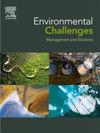Estimation of radiation doses of population residing nearby area of uranium ore mining and processing in Kazakhstan by tooth enamel EPR spectroscopy
Q2 Environmental Science
引用次数: 0
Abstract
To assess the impact of natural and technogenic radioactivity in uranium mining enterprises on the population, an investigation by the tooth enamel EPR (Electron Paramagnetic Resonance) dosimetry method was conducted for a group of the population living in the Stepnogorsk city (North Kazakhstan) placed near a uranium mining plant. Accumulated radiation EPR doses in enamel were assessed for 96 teeth samples.
From the measured values of EPR doses and the age of tooth enamel since its formation, the individual annual EPR dose rates (DR) were determined with average value of 1.75 ± 0.46 mGy/year corresponding to the hourly DR of 0.20 ± 0.05 µGy/hour (here and below after ± sign the error of the mean is shown). Data on the individual DR were analyzed for samples collected for population of different parts of Stepnogorsk (microdistricts). These data were compared with ambient dose equivalent rate (ADER) of gamma radiation measured by the conventional instrumental dosimetry. No significant differences in DR and ADER between microdistricts were found. The average ADER through the microdistricts of Stepnogorsk was 0.23 ± 0.01 µGy/hour (corresponding to 2.0 ± 0.1 mGy/year), which is consistent with the average DR measured by EPR.
For some tooth donors significantly higher individual EPR doses and DR, exceeding up to several times the bulk level for the investigated group of population were obtained. These high values may be result of local increased radiation level caused by the wastes of uranium mining enterprises.

牙釉质EPR光谱法估计哈萨克斯坦铀矿开采和加工区附近居民的辐射剂量
为了评估铀矿开采企业的自然和技术放射性对人群的影响,采用牙釉质EPR(电子顺磁共振)剂量法对居住在斯捷普诺戈尔斯克市(北哈萨克斯坦)铀矿厂附近的一组人群进行了调查。对96个牙齿样本进行了牙釉质累积辐射EPR剂量评估。根据EPR剂量的测量值和牙釉质形成以来的年龄,确定个体的年EPR剂量率(DR),其平均值为1.75±0.46 mGy/年,对应每小时DR为0.20±0.05µGy/小时(±符号后显示平均值的误差)。对在斯捷特诺戈尔斯克不同地区(微区)收集的人群样本进行个体DR数据分析。这些数据与常规仪器剂量学测量的伽马辐射的环境剂量当量率(ADER)进行了比较。微区间DR和ADER无显著差异。通过Stepnogorsk微区的平均ADER为0.23±0.01µGy/hour(对应2.0±0.1 mGy/year),与EPR测得的平均DR一致。对于一些牙齿供体,获得了显著较高的个体EPR剂量和DR,超过调查人群总体水平的几倍。这些高值可能是铀矿企业废弃物造成当地辐射水平升高的结果。
本文章由计算机程序翻译,如有差异,请以英文原文为准。
求助全文
约1分钟内获得全文
求助全文
来源期刊

Environmental Challenges
Environmental Science-Environmental Engineering
CiteScore
8.00
自引率
0.00%
发文量
249
审稿时长
8 weeks
 求助内容:
求助内容: 应助结果提醒方式:
应助结果提醒方式:


